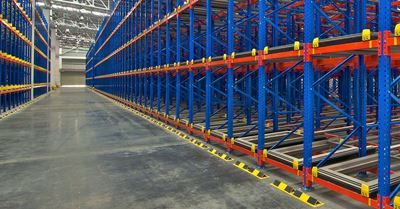Push Back Rack | Seattle

Raymond West offers pushback rack in a variety of styles and capacities.
We are one of the largest industrial racking suppliers in the state.
Call us today at (253) 333-2100
What Is Push Back Racking?
Push back racking (sometimes called pushback rack) is a high density pallet storage system that allows pallets to be stored anywhere from 2 to 6 units deep. Pallets ride on nested carts that are pushed up a modest incline as products are added, or “pushed back” from the face of the racking system.
When pallets are later unloaded, the pallet abutting the front pallet glides back down the slope to the nearest slot.
Push Back Rack Advantages And Disadvantages
Pushback racking is ideal for certain operations, but is not suitable for some storage requirements. There are several favorable and possibly unfavorable aspects to investigate.
Higher Density Storage
Given that push back pallet racks can accommodate anywhere from 2-6 pallets in any given lane, they can reclaim somewhere from 1-5 aisles, which represents a significant chunk of warehouse square footage.
Less Forklift Travel
By eliminating aisles, forklifts don’t have to make as many trips, reducing equipment wear and increasing efficiency. Diminished forklift traffic also makes a safer environment within the warehouse. Fewer trips is an easy way to guarantee a lower number of accidents.
Greater Selectivity
Pushback rack provides an ideal mixture of storage density and selectivity. Different from drive-in rack, where whole storage bays are typically one SKU, pushback rack offers straightforward access to a much greater number of pallet slots from the rack front.
LIFO Configuration
Dissimilar to pallet flow rack, which is a First In First Out (FIFO) variety of system, push back rack is a Last In First Out (LIFO) style of storage. This means that it’s not generally suitable for products that are perishable, because items that are loaded early may sit for quite a long period of time as products are added and depleted from the aisle.
How Does Push Back Racking Work?
Push back rack configurations include a set of tracks slanting in the direction of the aisle and a series of interlinked shuttles which ride on these rails.
The first pallet is added on the highest cart by a lift truck. When another pallet is added, the forklift driver forces the first pallet back and positions the second pallet on the adjacent cart. The last pallet positioned in the lane rests on the rails.
As goods are retrieved, carts of products glide down the rails. Lift truck drivers remove each pallet in succession until the lane is clear, or add pallets, filling the lane back up.
Push Back Pallet Racking For Sale
If you’re in the market for a push back racking system, contact a racking expert at Raymond West today. Our warehouse design engineers can help you find a system that is perfect for your operation.
Raymond's Seattle service operation includes most of Western Washington, including Seattle, Bellevue, Kirkland, Redmond, Bothell, Woodinville, Lynnwood, Everett, Tukwila, Renton, SeaTac, Burien, Kent, Federal Way, Fife, Sumner, Auburn, Tacoma, Lakewood, Puyallup, Olympia, Lacey and surrounding areas.
Raymond West | Seattle Material Handling Equipment Supplier
6607 S 287th St
Auburn, WA 98001
(253) 333-2100

